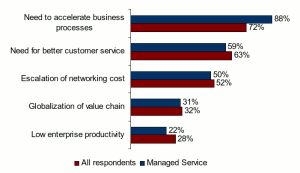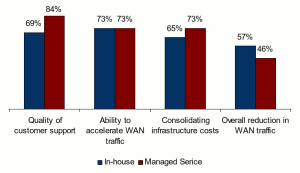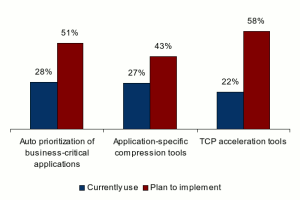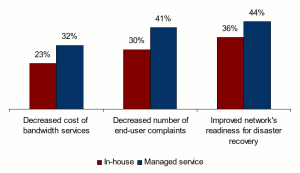
Aberdeen’s benchmark report, “Optimizing WAN for Application Acceleration” (see also the latest research, “Managed Network Services: Beyond Cost Savings and Uptime”), found that Best-in-Class organizations are 69 percent more likely to outsource optimization of their WANs (wide area networks) to third parties as compared to Laggards. This research also reveals that these organizations realize that the effectiveness of different WAN optimization initiatives varies based on the types of applications being managed and the internal capabilities that organizations have in place.
This article examines how organizations outsourcing their WAN optimization initiatives to third parties go about achieving their goals for application performance, reducing operational costs, and streamlining enterprise infrastructure.
It’s Not All About the Cost
Figure 1 shows that end-user organizations are driven to outsource optimization of their WANs predominantly by the need to accelerate their business processes and serve their customers better. Interestingly, organizations using managed services for WAN optimization are less likely to be driven by the need to optimize networking costs as compared to all other organizations participating in Aberdeen’s research.
The research shows that the perception of organizations outsourcing network management to the third party predominantly for the reasons of reducing operational costs and achieving operational efficiencies is changing. Organizations that are outsourcing optimization of their WANs are doing it predominantly in order to streamline their key processes and improve performance of mission-critical applications. Though these organizations do expect to achieve cost savings from these initiatives, cost is not the key pressure driving the adoption of outsourcing optimization.
Figure 2 shows that organizations outsourcing management of their WAN optimization initiatives are more likely to use quality of customer support as a selection criterion when evaluating technology solutions. These organizations are also giving higher consideration to technology vendors who can enable them to consolidate infrastructure cost as compared to organizations that are deploying in-house managed WAN optimization solutions. It is important to point out that the ability to accelerate WAN traffic is equally important to both groups of organizations. Even though leveraging WAN optimization solutions as a managed service is associated with operational benefits such as shorter implementation times, reduced labor costs, and consolidation of infrastructure cost, organizations currently deploying these solutions have the same expectations in terms of application performance over the WAN as their peers who are deploying internally managed solutions.
Capabilities and Performance
Aberdeen’s recent benchmark report, “The Roadmap to the Next Generation Branch Office Networks” (and see also the latest research, “Managed Network Services: Beyond Cost Savings and Uptime”, reveals that on average organizations have centralized 63 percent of their servers. The report also reveals that on average 59 percent of the workforce currently works outside of corporate headquarters. When dealing with issues of a geographically dispersed workforce while moving in the direction of centralizing corporate data and applications, the seamless delivery of applications and data to the end-user is becoming increasingly challenging. Figure 3 shows that organizations outsourcing the management of their networks plan to significantly expand their capabilities over the next 12 months.
Sixty-six percent of organizations using WAN optimization as a managed service reported that VoIP (voice over Internet protocol) deployment is the infrastructure project that is having the most significant impact on the performance of their WAN. As VoIP competes for available bandwidth with other mission-critical applications, it becomes increasingly important for these organizations to be able to prioritize network traffic and dedicate more bandwidth capacity to mission-critical and time-sensitive applications — such as VoIP. It is encouraging that by the end of 2008, nearly 80 percent of these organizations say they will have tools in place for prioritizing network traffic and implementing Quality-of-Service (QoS) policies (Figure 3). The adoption of these tools in combination with technology solutions for application acceleration and reduction of the amount of WAN traffic will allow these organizations to move a step closer to achieving their WAN optimization goals.
Figure 4 shows that organizations outsourcing their WAN optimization projects to a third-party provider are more likely to decrease the cost of bandwidth services as compared to their peers. Aberdeen’s research shows that these organizations were able to reduce the network management labor cost (measured as a percentage of total IT spend) by 10 percent as compared to a 4 percent decrease for all other organizations that participated in the study.
Figure 4 also shows that organizations using managed services as a delivery method to optimize their WANs are more likely to improve application performance (as measured by the number of end-user complaints). The quality of application performance and enabling seamless access to mission-critical information are the key performance metrics to these organizations. Figure 1 shows that the acceleration of business processes and responsiveness to customer needs are the top pressures that are driving the adoption of WAN optimization managed services. Additionally, as more organizations strive to expand their global presence, they must deal with WAN latency issues when delivering mission-critical data to their remote employees. Aberdeen’s research shows that on average, organizations outsourcing their WAN optimization initiatives report a 62 percent decrease in WAN latency as compared to a 48 percent decrease for organizations deploying in-house managed WAN optimization solutions.
The fact that these organizations are able to outperform their peers in several metrics related to the level of achievement of these goals speaks about the success of the strategies these organizations are employing for optimizing their Wide Area Networks. There are several different approaches that technology vendors in WAN optimization and application acceleration markets take to enable end-users to improve bandwidth utilization and application performance over the WAN. Organizations outsourcing their WAN optimization projects are able to benefit from their service providers’ expertise when evaluating these approaches and solutions and thus to deploy WAN optimization and application acceleration techniques that best fit their needs.
Next Steps
Even though organizations using WAN Optimization as a managed service are succeeding in reducing their network management labor costs and the cost of telecommunication services while improving application performance, there is still a lot of room for improvement.
Figure 3 shows that more than a half of these organizations currently do not have some key capabilities for WAN optimization and application acceleration. The majority of these organizations plan to develop these capabilities by the end of the year, but in the meantime these organizations need to educate themselves about the strengths and weaknesses of services provided by different technology vendors. As Aberdeen’s research shows, the quality of customer support is one of the key attributes these organizations consider when evaluating solution providers. End-user organizations need to focus on vendors that are making investments in time and resources to help the end-user resolve any network and/or application performance issues in the shortest time possible.
Read Aberdeen’s latest benchmark report on the subject, “Managed Network Services: Beyond Cost Savings and Uptime.”
Bojan Simic is a senior research analyst in network management at the Aberdeen Group.



















































Outsourcing has so many benefits:
1) Cost Savings
2) Time Zone Benefits
3) Quick Turn Around Time
4) Standardizing Business Processes
and many more….
http://www.outsourcewebsite.com